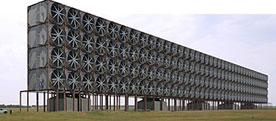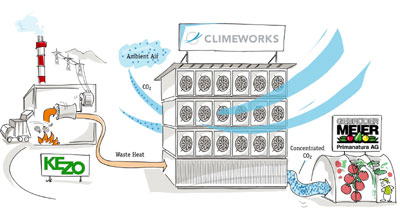We’re very excited to hear that a company that pulls carbon out of the atmosphere is beginning commercial operations this year.
At the rate the world is attacking climate change – nowhere near fast enough – we’re convinced this technology is absolutely essential and we are counting on it to scale quickly.
Switzerland-based Climeworks says it will start removing carbon this summer, starting with 1000 metric tons a year, reports Bloomberg. That’s a tiny amount – about the carbon emissions of 200 British residents – but this is the first time carbon will be removed and then sold.
To put it in perspective, in 2014, humans spewed 36 billion metric tons of carbon into the atmosphere. And that doesn’t account for the amount that has accumulated as emissions are 60% higher now than in 1990.
Climeworks’ process is deceptively simple – air is pulled into steel boxes using a fan that directs it through a specialized filter. There, carbon is chemically bound to the filter material and when that’s saturated, it is heated, turning it back into a gas … which can be sold.
The trick is heating it without using lots of energy. "The beauty of the process is that around 90% of the energy demand can be supplied by low-temperature heat" (from solar or waste heat from nearby buildings) and the rest through electricity.
Climeworks sets up these small, mobile "carbon removal boxes" right at customer sites.

The real hurdle, for now, is the high cost of this new technology – about $100 to remove a ton of carbon. Carbon is widely dispersed in the atmosphere in very tiny amounts. A carbon tax would make all the difference to quickly make it competitive.
But Climeworks has its first customer – a local greenhouse – and expects one of the largest carbonated drink manufacturers to sign on in the next few months, reports Bloomberg. The industry currently gets carbon gas from fossil fuels.
In 2007, Richard Branson launched the Virgin Earth Challenge, offering $25 million for the best geoengineering solution. Climeworks is among 11 finalists.
Another finalist is Carbon Engineering, which is also close to commercializing carbon air capture, but with large stationary structures. A demonstration plant in British Columbia is scrubbing 1 ton of carbon a day from the atmosphere. The company plans to follow it with a plant that converts the carbon into liquid biofuels.

Another air capture startup is Global Thermostat.
Last year, the Carbon XPRIZE launched, challenging researchers with a $20 million prize to develop products that can be made from capturing carbon emissions from coal and natural gas. This accelerates research already underway around the world, because it makes much more sense than capturing carbon and burying it underground.
Newlight Technologies makes plastic from emissions and Solidia makes cement that absorbs carbon as it hardens, for example.
Carbon air capture technologies are at about the same stage as solar panels were in the 1980s, in need of subsidies to bring it to scale, says Noah Deich, founder of the Center for Carbon Removal, in an interview with Yale360.
For other really cool technologies under development, read: Geoengineering Solutions Getting Closer, Gates, Branson Funding Them and Carbon XPRIZE Challenges Researchers to Reimagine Carbon.
We do not consider these technologies "geoengineering" because they don’t manipulate Earth’s natural systems, as fertilizing the oceans does, for example.
In the book, Atmosphere of Hope, Tim Flannery calls these technologies "Third Way."
Learn more about research on carbon removal:
